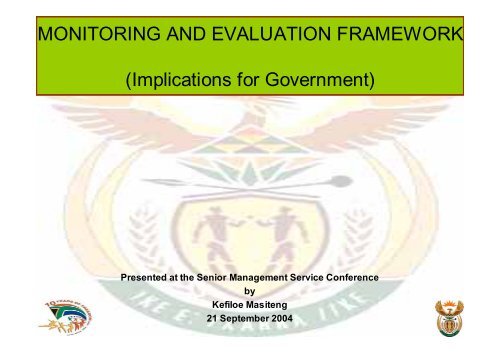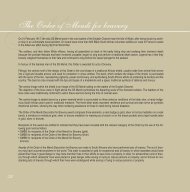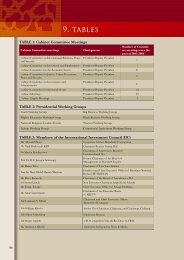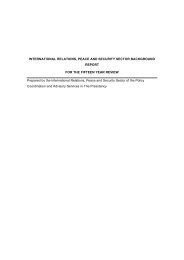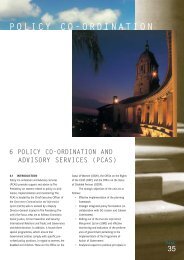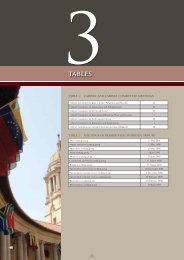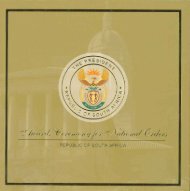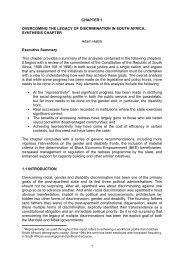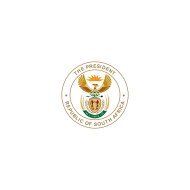MONITORING AND EVALUATION FRAMEWORK ... - The Presidency
MONITORING AND EVALUATION FRAMEWORK ... - The Presidency
MONITORING AND EVALUATION FRAMEWORK ... - The Presidency
Create successful ePaper yourself
Turn your PDF publications into a flip-book with our unique Google optimized e-Paper software.
<strong>MONITORING</strong> <strong>AND</strong> <strong>EVALUATION</strong> <strong>FRAMEWORK</strong><br />
(Implications for Government)<br />
Presented at the Senior Management Service Conference<br />
by<br />
Kefiloe Masiteng<br />
21 September 2004
INTRODUCTION<br />
M<strong>AND</strong>ATE<br />
• Monitoring and evaluation of<br />
government performance has<br />
been identified as a<br />
responsibility of the PCAS<br />
• <strong>The</strong> <strong>Presidency</strong> may evaluate the<br />
performance of government<br />
against set goals, targets,<br />
equitableness of resource<br />
allocation and effectiveness and<br />
efficiency in service delivery<br />
across all levels.<br />
OBJECTIVE<br />
To inform steps to be<br />
undertaken in creating a<br />
conducive environment enabling<br />
all levels of government, private<br />
sector, communities and<br />
individuals to achieve respective<br />
goals in service delivery and<br />
Improve performance.<br />
Hence the need to assess essential capacity in govt.
Monitoring versus Evaluation<br />
• <strong>MONITORING</strong><br />
Tracking changes in program performance<br />
over time<br />
• <strong>EVALUATION</strong><br />
Attributing program outcomes to their<br />
causes
<strong>MONITORING</strong><br />
WHY MONITOR<br />
• Monitoring in the government-wide<br />
framework refers to a set of activity<br />
and milestone tracing techniques, all<br />
of which measure some aspect of<br />
government performance including<br />
the measurement of the current<br />
status and change over time (trend<br />
analysis) in any of the initiatives.<br />
• Monitoring tracks changes in<br />
services provided (outputs) and the<br />
desired results (outcomes), providing<br />
the basis for accountability in the<br />
utilization of resources.<br />
BENEFITS<br />
• Monitoring can be put into<br />
place as a management tool<br />
that may be sustained over<br />
time. It can be used to improve<br />
initiatives by identifying<br />
aspects that are working<br />
according to plan and yielding<br />
positive results, while on the<br />
other hand it can identify those<br />
initiatives that need midcourse<br />
corrections.<br />
POA: Monitoring of the progress made in<br />
attaining the goals set in the SONA and Makgotla.<br />
Cluster POAs: Bi-monthly reporting to Cabinet
<strong>MONITORING</strong> C0MPONENTS<br />
Monitoring processes:<br />
• Development and definition of indicators<br />
to measure the progress made towards<br />
meeting relevant objectives<br />
• Data collection mechanisms for and<br />
monitoring systems to collate data on<br />
indicators<br />
• Data verification, validation and systems<br />
clean up<br />
• Data analysis to determine outputs,<br />
outcomes and trends<br />
• Report writing on the progress made on<br />
implementation<br />
• Distribution and feedback mechanisms<br />
across the entire spectrum of relevant<br />
stakeholders.<br />
Capacity needed for Govt:<br />
• Understanding of the<br />
POA on GOVT. website<br />
• Ability to develop<br />
relevant indicators for<br />
the initiatives and<br />
interventions arising<br />
from the cluster POA<br />
• Information collection<br />
strategy on the<br />
developed indicators<br />
• Analysis and verification<br />
of collected information<br />
• Report writing<br />
• Communication link with<br />
GCIS
DEVELOPMENT <strong>AND</strong> DEFINITION OF<br />
RELEVANT INDICATORS<br />
• Indicators development is based<br />
on goals and objectives for<br />
government<br />
• <strong>The</strong>se indicators may be<br />
calculated on the basis of<br />
description and formulae allocated<br />
to measure progress made<br />
(monitoring) or determining<br />
causality (impact assessment).<br />
– method for acquiring information<br />
on indicators,<br />
– responsibility for collection<br />
– Info./data source<br />
– frequency for updating<br />
• Agreement on evaluation methods<br />
• Role of <strong>Presidency</strong><br />
• Spearheading the<br />
indicator development<br />
based on POA<br />
• Setting in place<br />
collection, collation and<br />
report-back/feedback<br />
mechanisms
IMPACT ASSESSMENT<br />
• <strong>The</strong> purpose of impact assessment<br />
is primarily to measure the degree of<br />
change attributable to a particular<br />
initiative or intervention.<br />
• Impact assessment addresses the<br />
question of causality.<br />
• What differentiates the two<br />
processes are the evaluation<br />
techniques which might just include<br />
trend analysis in the case of<br />
monitoring and the analytic<br />
techniques used in impact<br />
assessment.<br />
• It determines how much of the<br />
observed change in the outcome<br />
(quality of life, access to services<br />
e.t.c) at the population can be<br />
attributable directly to the<br />
implementation of government<br />
policies and programmes and not to<br />
other factors.<br />
• <strong>The</strong> level of analysis for assessing<br />
the impact of government policies<br />
and programmes is the population<br />
(beneficiaries).<br />
•Lessons from the Ten Year Review are crucial<br />
•Planning for future government reviews based on TYR indicators<br />
•Development of Mid-term review indicators based on MTSF<br />
•Review and refinement of current TYR indicators
IMPACT ASSESSMENT<br />
• Development of assessment<br />
frameworks (modeling)<br />
• Collection and collation of data<br />
from different sources in relation<br />
to developed models<br />
• Regression (logistic, multivariate<br />
e.t.c) analysis on dependent and<br />
independent variables<br />
• Interpretation of results/findings to<br />
determine relationships<br />
• Report writing on the impact of<br />
government interventions to the<br />
population<br />
• Distribution of reports to relevant<br />
stakeholders<br />
PROCESSES<br />
Implications for <strong>Presidency</strong><br />
• Advanced policy analysis<br />
skills<br />
• Advanced data analysis<br />
skills<br />
• Basic data mining<br />
Basic statistical modeling skills<br />
• Econometrics<br />
• Demographic modeling<br />
(work with treasury on economic models)<br />
(Working with departments to compile a compendium of indicators)<br />
(work with Statssa on demographic/population dynamics & NSS)
DEVELOPMENT OF DATA COLLECTION<br />
MECHANISMS FOR INDICATORS<br />
• To enable comparisons (demographic,<br />
social, economic, financial and<br />
corporate governance) across the<br />
provinces, population groups, gender<br />
and age groups around government<br />
sectors over time and space.<br />
• <strong>The</strong> data collected on indicators will<br />
thus have to accommodate such<br />
comparisons and be disintegrated<br />
within the developed systems and<br />
databases according to the above<br />
mentioned categories, especially the<br />
GDC.<br />
• Role of Government<br />
– Data collection<br />
– Verification<br />
– Validation<br />
– Report writing
INFORMATION MANAGEMENT<br />
• <strong>The</strong> use of information systems in<br />
monitoring provides a reliable flow<br />
of information to allow<br />
management to keep abreast with<br />
the progress in the<br />
implementation of policy thrusts,<br />
programmes and activities based<br />
on decisions made in different<br />
gatherings.<br />
• Information systems facilitate<br />
assessment of the quality,<br />
quantity and timeliness of policy<br />
and programme inputs while<br />
operational constraints towards<br />
programme and policy<br />
effectiveness are identified, thus<br />
gaps may be addressed.<br />
• <strong>The</strong>y may further provide<br />
contextual information for<br />
evaluation processes.<br />
Role of <strong>Presidency</strong><br />
• Reporting Formats<br />
from FOSAD<br />
– (the project card)<br />
• EIMS<br />
– Roll out<br />
– TRAINING<br />
– Commitment<br />
• Integration with NSS<br />
(urgent to review)
Three models may be applied in monitoring<br />
and evaluation activities in Government<br />
• High level tertiary model: This model can be informed by State<br />
of the Nation address, Cabinet Decision and cluster priorities;<br />
• Government level monitoring and evaluation (PCAS): This<br />
model measures the progress made by government as a whole<br />
in addressing the objectives and implementing priority<br />
programmes;<br />
• Departmental Monitoring and Evaluation Initiatives:<br />
This level addresses the progress made by individual<br />
departments in implementing their programmes in line with<br />
government priorities. <strong>The</strong>se include indicators to measure<br />
programme level objectives (outputs), developed within each<br />
department in their informed by their strategic frameworks
Government model for systems<br />
integration at National level<br />
Govt.<br />
POA<br />
Executive<br />
Info.<br />
(CabEnet)<br />
Planning<br />
Government<br />
Statistics<br />
(Departmental routine<br />
sy stems)<br />
National Statistical System)<br />
M&E<br />
Programme level Statistics/Info<br />
(Departmental Information Systems)<br />
Provincial and Local Government M&E
OPERATIONALISING GOVERNMENT- WIDE<br />
<strong>MONITORING</strong> <strong>AND</strong> <strong>EVALUATION</strong> (PHASE 1)<br />
Five results, each of which will be delivered as a Report<br />
• A review of existing public service monitoring and evaluation systems.<br />
An early step in the process of creating a national monitoring and evaluation<br />
system for government will involve reviewing existing Departmental M&E<br />
systems so that existing capacity and capability is properly drawn upon.<br />
• A review of government reporting requirements, procedures and needs.<br />
• A review on progress in the development and implementation of government wide<br />
M&E systems by central or coordinating departments.<br />
• Results of consultations with all provincial administrations and FOSAD clusters on<br />
their performance indicators.<br />
• A logic model and framework architecture for a national M&E framework, (including<br />
a dashboard-style presentation of a national scorecard).
Monitoring and Evaluation<br />
Refining Monitoring and Evaluation system<br />
Improve quality of our outputs<br />
Provide an early warning system<br />
Improve statistical and information base.<br />
Cabinet<br />
Clusters and Depts<br />
FOSAD & MANCO?<br />
Project Teams<br />
<strong>Presidency</strong>
Monitoring and Evaluation<br />
Government's Programme of Action<br />
Econom ic Cluster<br />
FIRST ECONOMY<br />
In dex | Next<br />
Actions Departments Tim eframe Progress<br />
1.00 BROAD ECONOMIC STANCE<br />
1.01 N o significant cha nges to m acroeconom ic<br />
m anag em ent foreseen .<br />
NT Ong oing Continuing<br />
1.02 In fla tion targeting to re m ain in pla ce NT Ong oing Continuing<br />
1.03 <strong>The</strong> Execu tive sho uld work w ith the m onetary<br />
authorities to ensure th at the objective of a sta ble<br />
and com petitive exch ange rate and approp riate<br />
inflation range is attained<br />
NT Ong oing Con tinu ing thro ugh<br />
ordinary cha nnels<br />
1.04 Shift to m icro eco nom ic re form s dti, N T,<br />
Presid ency<br />
Ong oing<br />
Ongoin g<br />
2.00 INCREASED LEVELS OF INVESTM ENT IN<br />
PUBLIC INFRASTRUCTURE<br />
2.01 D eve lop sector-specific infrastructure in vestm ent<br />
plans<br />
2.02 <strong>The</strong> developm ent of financing stra teg ies to<br />
im plem en t plans including Public Private<br />
Partnership s and sim ilar m echanism<br />
2.03 Im p lem entatio n o f an appro priate regulatory<br />
fram ew ork to stim ulate new S tate Ow ned<br />
Enterprise investm en t in infrastructure<br />
DPE, DM E, d ti,<br />
NT, DOT<br />
DPE, DM E, d ti,<br />
NT, DOT<br />
DPE, NT,<br />
Presid ency<br />
2.04 Strengthenin g o f sector regu lato rs DPE, DM E,<br />
DOC<br />
N ov-04<br />
Sep -04<br />
Sep -04<br />
C ontinuous<br />
Progre ssing<br />
Progre ssing<br />
Progre ssing<br />
2.05 Strengthenin g o f th e G ove rnm ent cap acity to<br />
oversee the State O wn ed Ente rprises<br />
DPE, NT,<br />
Presid ency<br />
C ontinuous<br />
2.06 Finalise C AP EX fin ancing strategy DPE et al Sep -04 Progre ssing<br />
2.07 Finalise G overnm ent-w ide review of the State<br />
Ow ned Enterprises perform an ce pra ctices<br />
2.08 B ette r utilis ation of P ub lic Inves tm ent<br />
C om m ission 's Isibaya fun d<br />
DPE, NT,<br />
DPSA<br />
Sep -04<br />
Draft policy to be<br />
com p lete d by N ovem ber<br />
2004<br />
Progre ssing<br />
NT, GDC N ov-04 Progre ssing<br />
2.09 Expedite Port re structuring DOT, DPE a.s.a.p B ill to be tab led in N C O P<br />
by Septem ber 200 4
Monitoring and Evaluation<br />
PROGRAMME OF ACTION<br />
Governance and Administration (G&A Cluster)<br />
Policy Objective 4.00 - MACRO-ORGANISATION OF THE ST ATE<br />
Program me Activity 4.04.2 - Build 60 Multi Purpose Community Centres (MPCCs) and finalise plans to<br />
have at least one of these in each of our 284 municipal areas<br />
Project Team: GCIS<br />
People’s Contract/Partnerships:<br />
Timeframes: Dec-04<br />
WORK IN PROGRESS<br />
Strategic Policy Issues:<br />
Performance Indic ators:<br />
Level of Progress:<br />
Fast Tracking Implementation:<br />
Challenges:<br />
Comments:
ROLE OF COORDINATING<br />
DEPARTMENTS<br />
Institutions at the centre of government need to take the initiative in designing<br />
performance assessment systems for the whole of government i.e PCAS, OPSC,<br />
National Treasury, DPSA, DPLG.<br />
<strong>The</strong>se should link clearly into the Medium Term Expenditure and Strategic Frameworks<br />
and should show how assessments and evaluations should deliver useful information<br />
with practical recommendations.<br />
Such transversal systems could include:<br />
• Good governance (OPSC/<strong>Presidency</strong>)<br />
• Value for Money (National treasury)<br />
• Service Delivery (DPLG/OPSC)<br />
• Human Resource utilization (DPSA)<br />
• An Early Warning Systems (DPSA/<strong>Presidency</strong>)
ROLE OF SECTOR DEPARTMENTS<br />
Government wide M&E system will be operationalised on the<br />
understanding that each individual department will take responsibility for<br />
their own monitoring and evaluation processes according to the<br />
guidelines and standards mentioned above.<br />
• Monitoring is meant to take place at three different levels:<br />
‣ Implementation monitoring, evaluation, early warning and data collection – at all<br />
three spheres of government using inputs, outputs and outcome indicators<br />
‣ Monitoring of national departmental inputs, outputs and outcomes – by the<br />
coordinating departments (PCAS, OPSC, National Treasury, DPSA, DPLG)<br />
‣ Monitoring of process inputs, outputs and outcomes – by the departments<br />
themselves<br />
• Evaluation will also take place at these three levels but will be restricted to<br />
process and impact analysis.
ROLE OF PROVINCIAL <strong>AND</strong> LOCAL<br />
GOVERNMNET<br />
• Operationalisation of the framework will comprise provincial, departmental systems<br />
and the government wide supplementary systems listed above, some of which still<br />
need to be developed. Work on such development should be considered a priority.<br />
• Government wide M&E system will be operationalised on the understanding<br />
that individual Provinces will take responsibility for their own monitoring and<br />
evaluation processes according to the guidelines and standards mentioned<br />
above.<br />
• <strong>The</strong> role of Premier’s Offices in driving provincial M&E will also need a<br />
special focus. This highlights the need for the offices of the Premiers in all<br />
Provinces to establish monitoring and evaluation processes and apply them<br />
to local government.
Components of Programme Monitoring and<br />
Impact Assessment<br />
Program level<br />
Population level<br />
INPUTS PROCESSES OUTPUTS OUTCOMES<br />
Resources:<br />
•Personnel<br />
•Equipment<br />
•Finance<br />
Project Cycle: Phases<br />
1. Housing Dev. Process<br />
•Access to land<br />
•Land avail. Agreement<br />
2. Planning Process<br />
•Layout<br />
•Civil eng. Design<br />
3. Township est. process<br />
•Install Civ. Eng. Services<br />
•Units construction<br />
4. Hand over process<br />
•Keys to beneficiaries<br />
Deliverables<br />
•Serviced sites<br />
•Subsidies approved<br />
•Units completed<br />
•Units under const.<br />
•Projects approved<br />
•Fem. Headed H/holds<br />
•Budget & Exp.<br />
Impact<br />
•Housing access<br />
•Better lives<br />
• % Beneficiaries<br />
•Objectives met<br />
Monitoring<br />
Impact<br />
Assessment
RELEVANT SKILLS <strong>AND</strong> RESOURCES<br />
REQUIRED<br />
• Research;<br />
• statistical/ data analysis;<br />
• specialized software to perform modeling and<br />
other evaluation techniques;<br />
• Research design for evaluation may include<br />
population surveys, community surveys or<br />
forums, focus groups as well as randomized<br />
experiments;<br />
• Policy analysis and report writing.
Key Questions for Program M&E<br />
• What is a program?<br />
• Nationally organized, often<br />
publicly sponsored, effort to<br />
deliver social-economic<br />
services to target<br />
populations with need<br />
• Organizational systems<br />
activated for service<br />
delivery<br />
• Indefinite lifetime<br />
• Has an institutional host<br />
that is organic, of known<br />
size, adaptive, and<br />
operates in a changing<br />
environment<br />
• Did the program achieve<br />
its objectives?<br />
• Were the results<br />
attributable to program<br />
efforts?<br />
• Which program activities<br />
were more or less<br />
important/effective?<br />
• Did the intended benefit<br />
from the program?<br />
• At what cost?
Scope of Program M&E<br />
• What level of program evaluation?<br />
• National, subnational, specific site?<br />
• Implications for M&E design<br />
• Inference of results<br />
• Relevant time frame?<br />
• Relevant units of action?
RELEVANT SKILLS <strong>AND</strong> RESOURCES<br />
REQUIRED<br />
• Research;<br />
• statistical/ data analysis;<br />
• specialized software to perform modeling and<br />
other evaluation techniques;<br />
• Research design for evaluation may include<br />
population surveys, community surveys or<br />
forums, focus groups as well as randomized<br />
experiments;<br />
• Policy analysis and report writing.
Illustration of Program Monitoring<br />
Program<br />
outcome<br />
indicator<br />
Program<br />
start<br />
TIME-><br />
Program<br />
end
Illustration of Program Monitoring<br />
Program<br />
outcome<br />
indicator<br />
Actual?<br />
Program<br />
start<br />
TIME-><br />
Program<br />
end
Illustration of Program Impact<br />
With program<br />
Change<br />
in<br />
program<br />
outcome<br />
Without<br />
program<br />
Program<br />
start<br />
TIME-><br />
Program<br />
end
Illustration of Program Impact<br />
Change<br />
in<br />
program<br />
outcome<br />
Program<br />
impact<br />
With program<br />
Without<br />
program<br />
Program<br />
start<br />
TIME-><br />
Program<br />
end
<strong>The</strong> Role of the<br />
Logical/Strategic/Conceptual Framework<br />
• Logical vs Strategic vs Conceptual<br />
• Clarify program objective/strategic<br />
outcome/dependent variable<br />
• Interrelate units, levels and directions of<br />
action<br />
• Allow for consensus-building around a<br />
common paradigm
Example of a Strategic Framework<br />
Strategic Objective/Priority<br />
Objective 1 Objective 2<br />
Indicator 1<br />
Indicator 2<br />
Indicator 1<br />
Indicator 2<br />
Indicator 3
Example of a Conceptual Framework<br />
for a Structural Model<br />
Individual<br />
demand<br />
Program<br />
supply<br />
Service<br />
utilization<br />
Output of<br />
delivery<br />
Adequacy of<br />
Delivery
Example of a Conceptual Framework<br />
a Structural Model<br />
Individual<br />
demand<br />
Program<br />
supply<br />
Technical<br />
inputs<br />
Service<br />
utilization<br />
Housing<br />
Delivery<br />
Institutional<br />
capacity<br />
Adequate<br />
Housing<br />
Selfsufficiency
Monitoring versus Evaluation<br />
Can good monitoring lead to good evaluation?<br />
• Can good monitoring lead to<br />
good evaluation?<br />
• Indicators = Significant and<br />
influential factors<br />
• Framework = <strong>The</strong>oretically<br />
sound model<br />
• Directionality = Temporally<br />
correct causal flow<br />
• Coupling<br />
quantitative<br />
and<br />
qualitative<br />
assessment<br />
methods<br />
• Levels = Appropriate hierarchy<br />
of units


